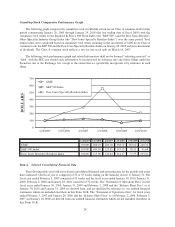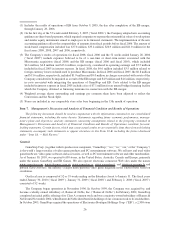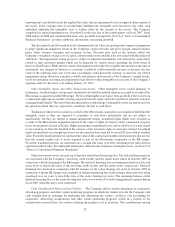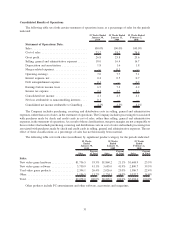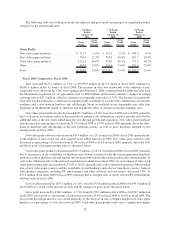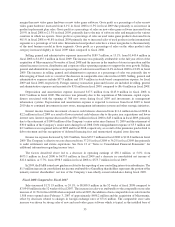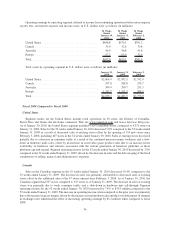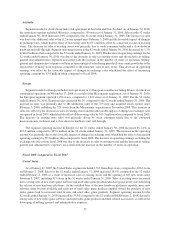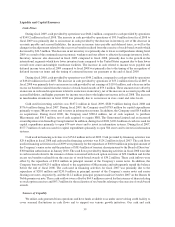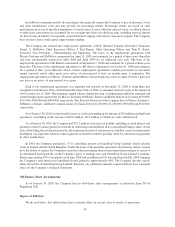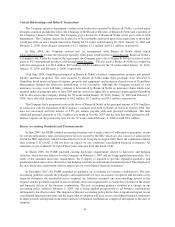GameStop 2009 Annual Report Download - page 49
Download and view the complete annual report
Please find page 49 of the 2009 GameStop annual report below. You can navigate through the pages in the report by either clicking on the pages listed below, or by using the keyword search tool below to find specific information within the annual report.new hardware platforms increases in the years following their launch. Stores are included in our comparable store
sales base beginning in the thirteenth month of operation and exclude the effect of changes in foreign exchange
rates.
New video game hardware sales increased $191.3 million, or 11.5%, from fiscal 2007 to fiscal 2008, primarily
due to the continued expansion of the installed base of new hardware platforms and the increase in store count since
the end of fiscal 2007, including the Micromania acquisition. New video game hardware sales decreased as a
percentage of sales from 23.5% in fiscal 2007 to 21.1% in fiscal 2008, primarily due to strong sales of new video
game software driven by the continued expansion of the installed base of new video game consoles and a strong
lineup of video game titles in fiscal 2008.
New video game software sales increased $884.3 million, or 31.6%, from fiscal 2007 to fiscal 2008, primarily
due to the strong sales of new video game titles released in fiscal 2008 and the increased sales of software related to
the new hardware platforms, as well as the new and acquired stores added since the end of fiscal 2007. New video
game software sales increased as a percentage of total sales from 39.5% in fiscal 2007 to 41.9% in fiscal 2008 due to
the continued expansion of the installed base of new video game consoles, as well as the availability of several
strong new titles in fiscal 2008.
Used video game product sales increased $439.9 million, or 27.7%, from fiscal 2007 to fiscal 2008, primarily
due to an increase in store count and an increase in the availability of hardware and software associated with the new
hardware platforms as those platforms age and expand. As a percentage of sales, used video game product sales
increased from 22.4% to 23.0% primarily due to the continued expansion of the installed base of new video game
consoles and the availability of used hardware and software from those consoles. Sales of other product categories,
including PC entertainment and other software and accessories, magazines and trading cards, grew 18.9%, or
$196.4 million, from fiscal 2007 to fiscal 2008, primarily due to the increase in store count and strong sales of new
PC entertainment software and sales of accessories related to new hardware platforms.
Cost of sales increased by $1,255.5 million, or 23.8%, from $5,280.3 million in fiscal 2007 to $6,535.8 million
in fiscal 2008 as a result of the increase in sales and the changes in gross profit discussed below.
Gross profit increased by $456.4 million, or 25.2%, from $1,813.7 million in fiscal 2007 to $2,270.1 million in
fiscal 2008. Gross profit as a percentage of sales increased from 25.6% in fiscal 2007 to 25.8% in fiscal 2008. The
gross profit percentage increase was caused primarily by the shift in sales from new video game hardware to new
video game software and used video game products as a percentage of total sales in fiscal 2008 as the new platforms
mature. These product categories carry a significantly higher margin than new video game hardware. Gross profit as
a percentage of sales on new video game hardware decreased from 6.5% in fiscal 2007 to 6.1% in fiscal 2008 due
primarily to a decrease in product replacement plan sales. Gross profit as a percentage of sales on new video game
software and other products remained relatively consistent from 20.8% and 33.9%, respectively, in fiscal 2007
compared to 20.9% and 33.6%, respectively, in fiscal 2008. Gross profit as a percentage of sales on used video game
products decreased from 48.7% in fiscal 2007 to 48.1% in fiscal 2008 due to increased promotional activities and
higher refurbishment costs associated with an increase in production of refurbished hardware platforms during
fiscal 2008.
Selling, general and administrative expenses increased by $263.4 million, or 22.3%, from $1,182.0 million in
fiscal 2007 to $1,445.4 million in fiscal 2008. The increase was primarily attributable to the increase in the number
of stores in operation, and the related increases in store, distribution and corporate office operating expenses.
Selling, general and administrative expenses as a percentage of sales decreased from 16.7% in fiscal 2007 to 16.4%
in fiscal 2008. The decrease in selling, general and administrative expenses as a percentage of sales was primarily
due to leveraging as a result of the higher sales associated with the growth of the video game market and cost control
efforts. Foreign currency transaction gains and (losses) are included in selling, general and administrative expenses
and amounted to ($6.4) million in fiscal 2008, compared to $8.6 million in fiscal 2007.
Depreciation and amortization expense increased from $130.3 million in fiscal 2007 to $145.0 million in fiscal
2008. This increase of $14.7 million was due primarily to capital expenditures associated with the opening of
674 new stores during fiscal 2008.
34


